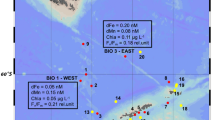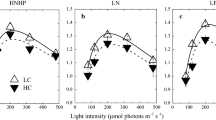Abstract
The effect of combined iron, silicate, and light co-limitation was investigated in the three diatom species Actinocyclus sp. Ehrenberg, Chaetoceros dichaeta Ehrenberg, and Chaetoceros debilis Cleve, isolated from the Southern Ocean (SO). Growth of all species was co-limited by iron and silicate, reflected in a significant increase in the number of cell divisions compared to the control. Lowest relative Si uptake and drastic frustule malformation was found under iron and silicate co-limitation in C. dichaeta, while Si limitation in general caused cell elongation in both Chaetoceros species. Higher light intensities similar to SO surface conditions showed a negative impact on growth of C. dichaeta and Actinocyclus sp. and no effect on C. debilis. This is in contrast to the assumed light limitation of SO diatoms due to deep wind driven mixing. Our results suggest that growth and species composition of Southern Ocean diatoms is influenced by a sensitive interaction of the abiotic factors, iron, silicate, and light.










Similar content being viewed by others
References
Abelmann A, Gersonde R (1991) Biosiliceous particle flux in the Southern Ocean. Mar Chem 35:503–536
Admiraal W (1977) Influence of light and temperature on the growth rate of estuarine benthic diatoms in culture. Mar Biol 39:1–9
Anderson M et al (2004) Light climate and primary productivity in the Arctic, UNIS Publication Series, AB323 Report ISBN 82-481-0010-3, pp 1–95
Banse K (1991) Rates of phytoplankton cell division in the field and in iron enrichment experiments. Limnol Oceanogr 36:1886–1898
Blain S et al (2002) Quantification of algal iron requirements in the subAntarctic Southern Ocean (Indian sector). Deep Sea Res Part II 49:3255–3273
Brzezinski MA (1992) Cell-cycle effects on the kinetics of silicic acid uptake and resource competition among diatoms. J Plankton Res 14:1511–1539
Brzezinski MA et al (1990) Silicon availability and cell-cycle progression in marine diatoms. Mar Ecol Prog Ser 67:83–96
Brzezinski MA et al (2005) Control of silica production by iron and silicic acid during the Southern Ocean Iron Experiment (SOFeX). Limnol Oceanogr 50:810–824
Chisholm SW (1992) Phytoplankton size. In: Falkowski PG, Woodhead AD (eds) Primary productivity and biogeochemical cycles in the sea. Plenum Press, New York
Claquin P et al (2002) Uncoupling of silicon compared with carbon and nitrogen metabolisms and the role of the cell cycle in continuous cultures of Thalassiosira pseudonana (Bacillariophyceae) under light, nitrogen, and phosphorus control. J Phycol 38:922–930
Coale KH et al (2003) Phytoplankton growth and biological response to iron and zinc addition in the Ross Sea and Antarctic circumpolar current along 170°W. Deep-Sea Res Part II 50:635–653
Coale KH et al (2004) Southern Ocean iron enrichment experiment: carbon cycling in high- and low-Si waters. Science 304:408–414
Dafner EV, Mordasova NV (1994) Influence of biotic factors on the hydrochemical structure of surface water in the Polar Frontal Zone of the Atlantic Antarctic. Mar Chem 45:137–148
de Baar HJW et al (1990) On iron limitation of the Southern Ocean: experimental observations in the Weddell and Scotia Seas. Mar Ecol Prog Ser 65:105–122
de Baar HJW et al (2005) Synthesis of iron fertilisation experiments: from the iron age in the age of enlightenment. J Geophys Res, 110, C09S16. doi:10.1029/2004JC002601
de La Rocha CL et al (2000) Effects of iron and zinc deficiency on elemental composition and silica production by diatoms, Mar Ecol Prog Ser 195:71–79
Franck VM et al (2000) Iron and silicic acid concentrations regulate Si uptake north and south of the Polar Frontal Zone in the Pacific Sector of the Southern Ocean. Deep Sea Res Part II 47:3315–3338
Franck VM et al (2003) Iron and zinc effects on silicic acid and nitrate uptake kinetics in three high-nutrient, low-chlorophyll (HNLC) regions. Mar Ecol Prog Ser 252:15–33
Grasshoff K et al (1999) Methods of seawater analysis. 3rd edn, Wiley-VCH, Weinheim
Greene RM et al (1992) Iron-induced changes in light harvesting and photochemical energy conversion processes in eukaryotic marine algae. Plant Physiol 100:565–575
Greene RM et al (1994) Physiological limitation of phytoplankton photosynthesis in the eastern equatorial Pacific determined from variability in the quantum yield of fluorescence. Limnol Oceanogr 39:1061–1074
Harrison PJ et al (1977) Marine diatoms grown in chemostats under silicate or ammonium limitation. III. Cellular chemical composition and morphology of Chaetoceros debilis, Skeletonema costatum, and Thalassosira gravida. Mar Biol 43:19–31
Hillebrand H et al (1999) Biovolume calculation for pelagic and benthic microalgae. J Phycol 35:403–424
Hoffmann LJ et al (2006) Different reactions of Southern Ocean phytoplankton size classes to iron fertilization. Limnol Oceanogr 51:1217–1229
Hoffmann LJ et al (2007) Effects of iron on the elemental stoichiometry during EIFEX and in the diatoms Fragilariopsis kerguelensis and Chaetoceros dichaeta. Biogeosciences 4:569–579
Hutchins DA et al (2001) Control of phytoplankton growth by iron and silicic acid availability in the subAntarctic Southern Ocean: Experimental results from the SAZ project. J Geophys Res, 106:31559–31572
Jeffrey SW, Humphrey GF (1975) New spectrophotometric equations for determining chlorophylls a, b, c1 and c2 in higher plants, algae and natural phytoplankton. Biochem Physiol Pflanzen 167:191–194
Kolbowski J, Schreiber U (1995) Computer-controlled phytoplankton analyzer based on 4-wavelengths PAM chlorophyll fluorometer. In: Mathis P (ed) Photosynthesis: from light to biosphere, pp 825–828
Leblanc K et al (2005) Fe and Zn effects on the Si cycle and diatom community structure in two contrasting high and low-silicate HNLC areas. Deep Sea Res Part I 52:1842–1864
Leynaert A et al (2004) Effect of iron deficiency on diatom cell size and silicic acid uptake kinetics. Limnol Oceanogr 49:1134–1143
Martin-Jézéquel V et al (2000) Silicon metabolism in diatoms: implications for growth. J Phycol 36:821–840
Martin JH et al (1990) Iron deficiency limits phytoplankton growth in Antarctic waters. Global Biogeochem Cycles 4:5–12
Mitchell BG et al (1991) Light limitation of phytoplankton biomass and macronutrient utilization in the Southern Ocean. Limnol Oceanogr 36:1662–1677
Montagnes DJS et al (1994) Estimating carbon, nitrogen, protein, and chlorophyll a from volume in marine phytoplankton. Limnol Oceanogr 39:1044–1060
Morel FMM et al (1991) Limitation of productivity by trace metals in the sea. Limnol Oceanogr 36:1742–1755
Nelson DM, Smith WO Jr (1991) Sverdrup revisited: critical depth, maximum chlorophyll levels, and the control of Southern Ocean productivity by the irradiance-mixing regime. Limnol Oceanogr 36:1650–1661
Nelson DM et al (1995) Production and dissolution of biogenic silica in the ocean: revised global estimates, comparison with regional data and relationship to biogenic sedimentation. Global biogeochem Cycles 9:359–372
Paasche E, Østergren I (1980) The annual cycle of plankton diatom growth and silica production in the inner Oslofjord. Limnol Oceanogr 25:481–494
Raven JA (1990) Predictions of Mn and Fe use efficiencies of phototrophic growth as a function of light availability for growth and of C assimilation pathway. New Phytol 116:1–18
Sarthou G et al (2005) Growth physiology and fate of diatoms in the ocean: a review. J Sea Res 53:25–42
Sedwick PN et al (2002) Resource limitation of phytoplankton growth in the Crozet Basin, subAntarctic Southern Ocean. Deep Sea Res Part II 49:3327–3349
Sigmon DE et al (2002) The Si cycle in the Pacific sector of the Southern Ocean: seasonal diatom production in the surface layer and export to the deep sea. Deep Sea Res Part II 49:1747–1763
Strzepek RF, Price NM (2000) Influence of irradiance and temperature on the iron content of the marine diatom Thalassiosira weissflogii (Bacillariophyceae). Mar Ecol Prog Ser 206:107–117
Strzepek RF, Harrison PJ (2004), Photosynthetic architecture differs in coastal and oceanic diatoms. Nature 431:689–692
Sunda WG, Huntsman SA (1997) Interrelated influence of iron, light and cell size on marine phytoplankton growth. Nature 390:389–392
Thomas DN, Dieckmann GS (2002) Antarctic Sea Ice—a habitat for extremophiles. Science 295:641–644
Timmermans KR et al (2001) Co-limitation by iron and light of Chaetoceros brevis, C. dichaeta and C. calcitrans (Bacillariophyceae). Mar Ecol Prog Ser 217:287–297
Tréguer P, Jacques G (1992) Dynamics of nutrients and phytoplankton, and fluxes of carbon, nitrogen, and silicon in the Antarctic Ocean. Polar Biol 12:149–162
Tréguer P et al (1995) The silica balance in the world ocean: a reestimate. Science 268:375–379
Tsuda A et al (2003) A mesoscale iron enrichment in the western subArctic Pacific induces a large centric diatom bloom. Science 300:958–961
van Oijen T et al (2004) Light rather than iron controls photosynthate production and allocation in Southern Ocean phytoplankton populations during austral autumn. J Plankton Res 26:885–900
Acknowledgments
We thank Jesco Peschutter and Wiebke Schmidt for their help in cell counting, as well as Eike Breitbarth and Peter Croot for helpful comments and discussions. We also would like to thank the two anonymous reviewers for their constructive critics, which have remarkably improved the clarity of the manuscript. This research was funded by the German Research Foundation (DFG) grant PE_565_5.
Author information
Authors and Affiliations
Corresponding author
Rights and permissions
About this article
Cite this article
Hoffmann, L.J., Peeken, I. & Lochte, K. Iron, silicate, and light co-limitation of three Southern Ocean diatom species. Polar Biol 31, 1067–1080 (2008). https://doi.org/10.1007/s00300-008-0448-6
Received:
Revised:
Accepted:
Published:
Issue Date:
DOI: https://doi.org/10.1007/s00300-008-0448-6




